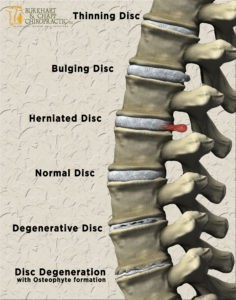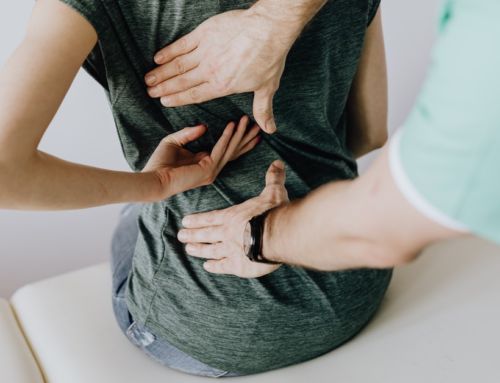Many patients who suffer from back pain are told their pain is caused by a spinal disc problem. This diagnosis can be confusing because many terms like herniated disc, disc degeneration, and nerve root pain are used interchangeably or never fully explained by a healthcare provider. To make matters more complicated, damage to a spinal disc does not always cause pain, and pain caused by something else is sometimes misdiagnosed as pain from a disc problem.
Here’s what you need to know about what’s really causing your back pain and how to treat it:

Herniated Discs, Bulging Discs, and Degenerated Discs– Oh My!
Your spine is a series of joints that allow for a wide range of movement. Vertebrae–the bones of the spine– are separated by cushy, rubbery structures called discs. A healthy disc is round in circumference and flat on the top and bottom, where it attaches to the vertebrae. It contains fluid that helps it absorb shocks.
Your spinal discs, especially those in your lower (lumbar) spine and neck (cervical spine), take a lot of wear and tear from movement and are susceptible to injury. A herniated disc is a disc that has a large tear in it that is leaking fluid. The fluid inside the disc can compress nerves around it as it leaks. It also contains inflammatory proteins that can cause inflammation around the nerve. A bulging disc is a disc that has shifted, so that part of it is sticking out between the vertebrae. Bulging discs are more likely to become herniated discs. Even if it doesn’t become herniated, a bulging disc can put pressure on a nerve. A strain or an injury usually causes herniated and bulging discs.
As we age, our discs harden and compress. This makes them less capable of absorbing shock and can lead to a reduced range of motion. Discs that are thinning and hardening as a result of age or other illnesses are called degenerating discs. This process happens in nearly everyone, and in most people, it doesn’t cause pain. When it does cause pain, it’s known as degenerative disc disease.
Disc Problems and Pain
As mentioned above, degenerating discs do not necessarily equal pain. The same is true of bulging and herniated discs. Sometimes these injuries cause pain; other times, there are no symptoms. The extent of the injury does not correlate with the amount of pain a patient experiences. Someone can be in severe pain and have a minor disc injury or have mild pain from a significant disc injury. These phenomena make it difficult to diagnose what may be causing a person’s back pain.
The spine is a complicated structure. In addition to the joints between vertebrae that are separated by discs, there are other joints in the spine called facet joints. These are the joints where the vertebrae attach to one another. Facet joints are a type of joint known as a synovial joint. Your knees, elbows, and most of your other joints are also synovial joints. This means they are surrounded by a sack of connective tissue that produces a lubricating liquid. These types of joints also contain cartilage, a smooth, rubber-like coating on the bones that helps them move smoothly. The spine is also the hub of your nervous system, and many nerves radiate out from it to different areas of your body.
Back pain can be caused by disc problems or by arthritis or inflammation in the facet joints. Sometimes a strained muscle or ligament will cause sever pain. Even if a disc problem is evident on an MRI, it is important to also rule out these other possible causes of pain. The proximity of nerves to all these structures means that inflammation near a nerve can cause pain that radiates down an arm or leg. The inflammation could be from a disc problem or from something else.

Pinpointing the Cause of Your Pain
Some health care providers use injections of local anesthetics like lidocaine to figure out what part of the spine is causing pain. If the joint or disc area injected is the primary cause of the pain, then the patient will feel relief from the anesthetic. If the patient doesn’t feel relief, then a different part of the spine is responsible for their pain.
Figuring out exactly what is causing your back pain is vital if you are considering surgery. Many back surgeries fail because the cause of the pain was misdiagnosed.
Treating Your Pain Without Surgery
Since back surgery is a risky procedure with a fairly low rate of success, many people are turning to non-surgical options to alleviate their back pain. One of the most effective non-surgical treatments is spinal decompression therapy. This treatment is ideal for back pain because it can treat several of the most common causes, including problems with the discs, facet joints, and nerves.
Some people experience damage to a disc or facet joint that heals without treatment. The human body has mechanisms that are meant to help us heal. In the case of back pain, the immune system can attack leaking disc fluid, cleaning it up, so it is no longer irritating nerves. Blood flow sends these immune cells in addition to oxygen and nutrients to injured areas to encourage healing. People who experience chronic pain have the same abilities to heal, but their bodies need a nudge in the right direction.
Spinal decompression therapy gently stretches the spine, creating negative pressure between the vertebrae. The negative pressure sucks bulging discs and leaking disc fluid back into place, alleviates pressure on the nerves, and speeds blood flow to the joints of the spine.
Studies have found that about 86% of patients experience lasting relief after a full series of spinal decompression treatments. Most patients experience some relief after their first treatment and continue to see improvement with each consecutive treatment. Spinal decompression therapy leads to real healing, without the need for invasive treatments or addictive pain killers.
At Burkhart Chiropractic, we have years of experience diagnosing and treating back pain. Call or click today to get on the road to a pain-free life.







